关于初二英语说课稿范文合集大全
初中英语全英说课稿优秀8篇
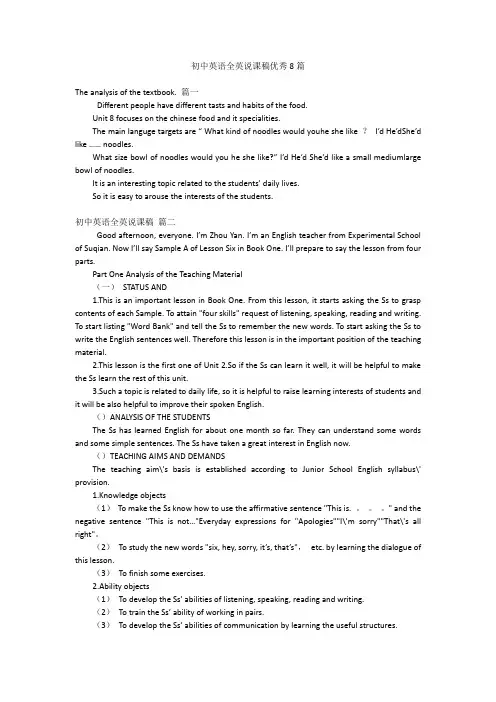
初中英语全英说课稿优秀8篇The analysis of the textbook. 篇一Different people have different tasts and habits of the food.Unit 8 focuses on the chinese food and it specialities.The main languge targets are “ What kind of noodles would youhe she like ?I’d He’dShe’d like …… noodles.What size bowl of noodles would you he she like?” I’d He’d She’d like a small mediumlarge bowl of noodles.It is an interesting topic related to the students’ daily lives.So it is easy to arouse the interests of the students.初中英语全英说课稿篇二Good afternoon, everyone. I’m Zhou Yan. I’m an English teacher from Experimental School of Suqian. Now I’ll say Sample A of Lesson Six in Book One. I’ll prepare to say the lesson from four parts.Part One Analysis of the Teaching Material(一)STATUS AND1.This is an important lesson in Book One. From this lesson, it starts asking the Ss to grasp contents of each Sample. To attain "four skills" request of listening, speaking, reading and writing. To start listing "Word Bank" and tell the Ss to remember the new words. To start asking the Ss to write the English sentences well. Therefore this lesson is in the important position of the teaching material.2.This lesson is the first one of Unit 2.So if the Ss can learn it well, it will be helpful to make the Ss learn the rest of this unit.3.Such a topic is related to daily life, so it is helpful to raise learning interests of students and it will be also helpful to improve their spoken English.()ANALYSIS OF THE STUDENTSThe Ss has learned English for about one month so far. They can understand some words and some simple sentences. The Ss have taken a great interest in English now.()TEACHING AIMS AND DEMANDSThe teaching aim\'s basis is established according to Junior School English syllabus\' provision.1.Knowledge objects(1)To make the Ss know how to use the affirmative sentence "This is. 。
人教版8年级初中英语说课稿(共5篇)
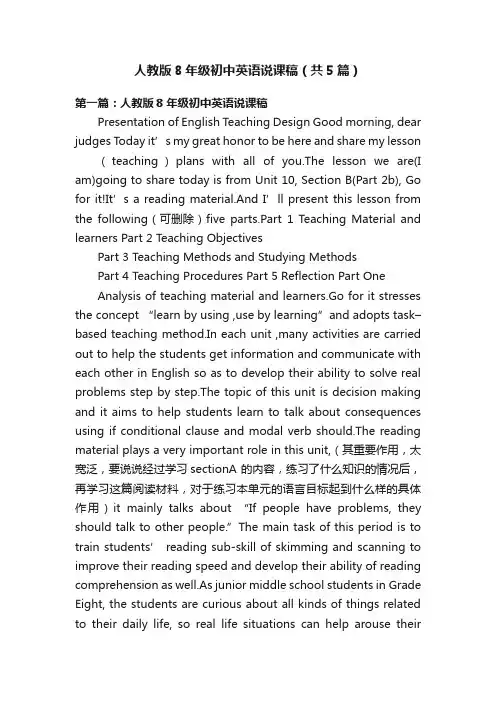
人教版8年级初中英语说课稿(共5篇)第一篇:人教版8年级初中英语说课稿Presentation of English Teaching Design Good morning, dear judges Today it’s my great honor to be here and share my lesson (teaching)plans with all of you.The lesson we are(I am)going to share today is from Unit 10, Section B(Part 2b), Go for it!It’s a reading material.And I’ll present this lesson from the following(可删除)five parts.Part 1 Teaching Material and learners Part 2 Teaching ObjectivesPart 3 Teaching Methods and Studying MethodsPart 4 Teaching Procedures Part 5 Reflection Part OneAnalysis of teaching material and learners.Go for it stresses the concept “learn by using ,use by learning”and adopts task–based teaching method.In each unit ,many activities are carried out to help the students get information and communicate with each other in English so as to develop their ability to solve real problems step by step.The topic of this unit is decision making and it aims to help students learn to talk about consequences using if conditional clause and modal verb should.The reading material plays a very important role in this unit,(其重要作用,太宽泛,要说说经过学习sectionA 的内容,练习了什么知识的情况后,再学习这篇阅读材料,对于练习本单元的语言目标起到什么样的具体作用)it mainly talks about “If people have problem s, they should talk to other people.”The main task of this period is to train students’ reading sub-skill of skimming and scanning to improve their reading speed and develop their ability of reading comprehension as well.As junior middle school students in Grade Eight, the students are curious about all kinds of things related to their daily life, so real life situations can help arouse theirinterest and enthusiasm.(此处学生对各种事物的好奇,可具体到学生的实际生活,会遇到各种困惑的问题那么通过本课课文的阅读可以给他们带来什么实际意义)Part Two Teaching ObjectivesAccording to the analysis above, I set the following teaching objectives: First, knowledge aims.The students will(will be able to use)use the following expressions properly: teenager;expert, unless, careless, careful experience, keep…to oneself, in half etc.and understand some important sentences such as “Unless we talk to someone, we’ll certainly feel worse.” “So you’re halfway to solving a problem just by talking to someone about it.”Second, ability aims.By the end of the class, the students will be able to skim(skim for the general idea)and scan for the specific information form the passage.Third, emotional aims.During the class, students’ cousciousness of sharing problems with others will be inspired.Among these points, I think the useful expressions and improvement of reading ability are the key and difficult teaching points.Part 3 Teaching Methods and Studying Methods According to modern teaching theories and the new curriculum standards, I will adopt task-based language teaching method, I will set the following activities such as : individual work , pair work and group work to achieve the teaching goals.(In order to achieve the teaching goals , the following activities such as : individual work , pair work and group work will be used)I will try my best to make students the real masters of the class, while teachers only as directors.(Independent study method)and the students will learn in a relaxing atmosphere by reading, speaking, thinking and discussing in groups.(Cooperation study method) And I’ll use the blackboard and the multi-media during myteaching.Part 4 Teaching Procedures To achieve the objectives above, I design several activities with the aid of PPT.The teaching procedures will follow PWP model(pre-reading,while-reading and post-reading).Step 1 Greetings T o begin the class, I’ll greet my students as usual.Step 2 Pre-readingI will lead in this lesson by showing the students a video(it is about a quarrel between my student and her best friend).In this video, the students will hear some new words for the first time, such as unless, angry, understanding.Then I will try to get advice from the students(possible answers: say sorry to her friend, give her a gift…..)After that I will show a photo of myself and tell them after talking to me, she feels better now.Then we can go into the topic of this lesson “If people have problems, they should talk to other people.”(The topic related to the students’ daily life closely, so they should be glad to disscuss it with me.) Step 3 while-reading During the while-reading process, I will design some activities for them to understand the passage better.Activity(可否换为task?)One: In order to improve their reading sub-skill of skimming, I’ll ask them to read the whole passage as quickly as possible and find out the answer to the following question: There are two persons(添加who)agree with the idea “If people have problems, they should talk to other people.” Who are they?(Through the question, students will get the main idea of this passage more clearly).Activity Two: In order to improve their reading sub-skill of scanning.The students will be asked to read Paragraph 1-2 and find some details about Laura.(They should use scanning----a process of searching for specific information.Here I’ll explain it to them first.)And during the activity, I want to show the difference between “careful” and “careless”(Let the students know something about theword-building, such as “home” and “homeless”, “help” and “helpless”….此处提出 ful,less 是两个相反的后缀,了解了这两个后缀对解决生词有很大帮助)Activity Three: Read Paragraph 3 and Tell T or F about Robert Hunt.(换换说法:check if some statements about Hunt are ture or false)(The students will practice the scanning skill again.)★(The answers to Activity Two and Three will use the key words and expressions in this lesson)★(这句话貌似Chinglish)★(The students will work in pairs or groups to finish Activity Two and Three)★Activity Four: I will ask the students to read the whole article (passage)again and raise questions to each other.(In this way, the students will be encouraged to think on their own.This can also give them a chance to share problems with other students).(任务不具体)Step 4 Post-reading After the students finish the reading, I’ll prepare an open-ended(是不是 open-minded?)activitiy.The students work in groups of 4 and talk about their own problems first, then they could write a short letter for(to)each other, in order to solve the problems.Then it’s sharing time!(They should know helping others is a good thing.)(step4 开放性问题和step3 中的活动四似乎有点重复,单纯的说看不出多少文章的升华和学以致用。
八年级英语说课稿5篇
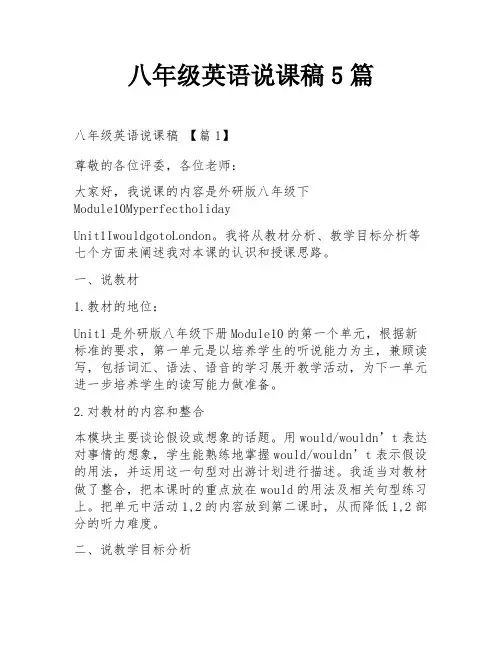
八年级英语说课稿5篇八年级英语说课稿【篇1】尊敬的各位评委,各位老师:大家好,我说课的内容是外研版八年级下Module10MyperfectholidayUnit1IwouldgotoLondon。
我将从教材分析、教学目标分析等七个方面来阐述我对本课的认识和授课思路。
一、说教材1.教材的地位:Unit1是外研版八年级下册Module10的第一个单元,根据新标准的要求,第一单元是以培养学生的听说能力为主,兼顾读写,包括词汇、语法、语音的学习展开教学活动,为下一单元进一步培养学生的读写能力做准备。
2.对教材的内容和整合本模块主要谈论假设或想象的话题。
用would/wouldn’t表达对事情的想象,学生能熟练地掌握would/wouldn’t表示假设的用法,并运用这一句型对出游计划进行描述。
我适当对教材做了整合,把本课时的重点放在would的用法及相关句型练习上。
把单元中活动1,2的内容放到第二课时,从而降低1,2部分的听力难度。
二、说教学目标分析根据教材的前后联系和意图以及英语课程标准的要求,我将本课的教学目标按知识与能力、过程与方法、情感态度与价值观三个方面细化:A.知识与能力:1.能听懂含有would的描述假期的听力和对话。
2.能够用would和would’t谈论自己理想的假期。
B.过程与方法:在教学中运用情景设置任务,学生自主探究、合作学习的方式,谈论自己理想的假期,培养学生的听说能力和合作意识。
C.情感态度与价值观:1.通过对话中对理想的描述,培养学生善于想象、乐于交流自己的理想假日的兴趣。
2.通过小组活动,角色表演,培养学生自主、合作、良好学习习惯。
三、说教学重难点依据课标:本课时就是用would来谈论假设的话题。
基于以上的分析,是这样确立本课时的重、难点的。
1、重点:以谈论假设的话题为中心,谈论各种情况下的可能性。
2、难点:1)表达猜想的词汇及它们在句中的正确运用。
2)能用恰当正确的英语介绍个人的旅游计划。
初中英语5分钟说课稿(15篇)
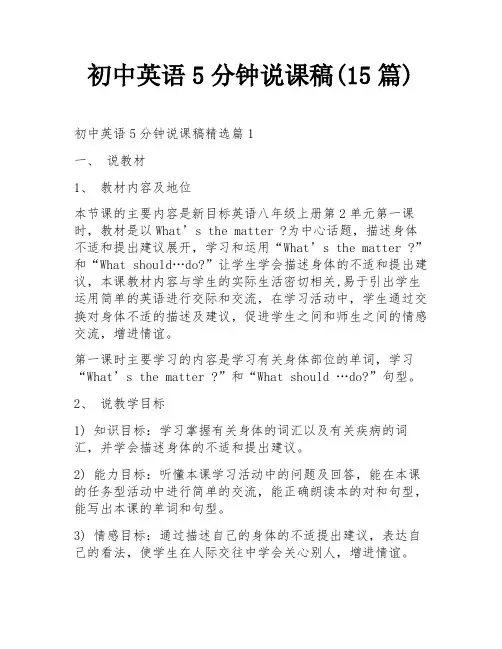
初中英语5分钟说课稿(15篇)初中英语5分钟说课稿精选篇1一、说教材1、教材内容及地位本节课的主要内容是新目标英语八年级上册第2单元第一课时,教材是以What’s the matter ?为中心话题,描述身体不适和提出建议展开,学习和运用“What’s the matter ?”和“What should…do?”让学生学会描述身体的不适和提出建议,本课教材内容与学生的实际生活密切相关,易于引出学生运用简单的英语进行交际和交流,在学习活动中,学生通过交换对身体不适的描述及建议,促进学生之间和师生之间的情感交流,增进情谊。
第一课时主要学习的内容是学习有关身体部位的单词,学习“What’s the matter ?”和“What should …do?”句型。
2、说教学目标1) 知识目标:学习掌握有关身体的词汇以及有关疾病的词汇,并学会描述身体的不适和提出建议。
2) 能力目标:听懂本课学习活动中的问题及回答,能在本课的任务型活动中进行简单的交流,能正确朗读本的对和句型,能写出本课的单词和句型。
3) 情感目标:通过描述自己的身体的不适提出建议,表达自己的看法,使学生在人际交往中学会关心别人,增进情谊。
4) 文化意识目标:用恰当的方式表达自己的看法,增进人际交往中学会关心别人的能力,了解英美国家询问和表达身体不适的习惯,培养世界意识。
3、说教学重难点重点:本节课主要学习身体部位的单词和一些疾病的词汇,以及身体不适的表达及建议。
难点:身体不适的表达及建议二、说学情初二年级的学生对英语已经有了一定的基础,但本地区部分学生对学习英语的兴趣不是很浓,在学习中,他们更喜欢从游戏中或活动中学习,这样更能提高他们的学习兴趣,让他们更轻松地掌握英语知识。
三、说教法作为教学的引导着,我遵循新课程“学生是学习的主人,一切的教学活动设计在以学生为本”的教学理念,坚持“为学生的发展,必须培养学生的自主性、能动性、独立性和创造性”的教学原则。
初中英语全英说课稿优秀9篇
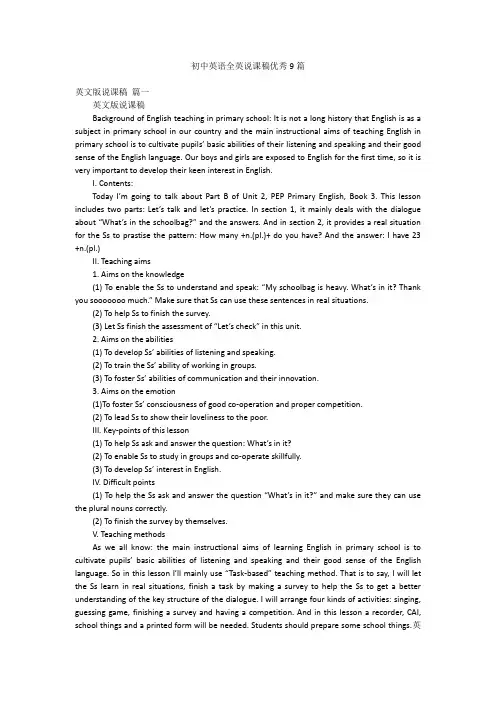
初中英语全英说课稿优秀9篇英文版说课稿篇一英文版说课稿Background of English teaching in primary school: It is not a long history that English is as a subject in primary school in our country and the main instructional aims of teaching English in primary school is to cultivate pupils’ basic abilities of their listening and speaking and their good sense of the English language. Our boys and girls are exposed to English for the first time, so it is very important to develop their keen interest in English.I. Contents:Today I’m going to talk about Part B of Unit 2, PEP Primary English, Book 3. This lesson includes two parts: Let’s talk and let’s practice. In section 1, it mainly deals with the dialogue about “What’s in the schoolbag?” and the answers. And in section 2, it provides a real situation for the Ss to prastise the pattern: How many +n.(pl.)+ do you have? And the answer: I have 23 +n.(pl.)II. Teaching aims1. Aims on the knowledge(1) To enable the Ss to understand and speak: “My schoolbag is heavy. What’s in it? Thank you sooooooo much.” Make sure that Ss can use these sentences in real situations.(2) To help Ss to finish the survey.(3) Let Ss finish the assessment of “Let’s check” in this unit.2. Aims on the abilities(1) To develop Ss’ abilities of listening and speaking.(2) To train the Ss’ ability of working in groups.(3) To foster Ss’ abilities of communication and their innovation.3. Aims on the emotion(1)To foster Ss’ consciousness of good co-operation and proper competition.(2) To lead Ss to show their loveliness to the poor.III. Key-points of this lesson(1) To help Ss ask and answer the question: What’s in it?(2) To enable Ss to study in groups and co-operate skillfully.(3) To develop Ss’ interest in English.IV. Difficult points(1) To help the Ss ask and answer the question “What’s in it?” and make sure they can use the plural nouns correctly.(2) To finish the survey by themselves.V. Teaching methodsAs we all know: the main instructional aims of learning English in primary school is to cultivate pupils’ basic abilities of listening and speaking and their good sense of the English language. So in this lesson I’ll mainly use “Task-based” teaching method. That is to say, I will let the Ss learn in real situations, finish a task by making a survey to help the Ss to get a better understanding of the key structure of the dialogue. I will arrange four kinds of activities: singing, guessing game, finishing a survey and having a competition. And in this lesson a recorder, CAI, school things and a printed form will be needed. Students should prepare some school things.英文版英语说课稿VI. Teaching procedures and purposes of my designing.I’ll finish this lesson in five steps.Step 1. Warm-up and preview1. Free talk between T and Ss about things in the classroom.2. Sing the song together: Books and pencils.3. Do some TPR, for example: Show me your English book. Show me your crayon.4. Review the numbers by asking: “How many crayons do you have?”Purpose: It is important to form a better English learning surrounding for the Ss by singing and doing some total physical response and at the same time it provides situations to review learned knowledge for the next step.Step 2. PresentationNow I’ll mainly talk about this step.1. Present the pattern: “My schoolbag is heavy.” “What’s in it?.”(1) Show a bag and say: “Look! I have a bag.” Carry it and say: “Oh, it is heavy. My schoolbag is heavy.” Help the Ss understand the meaning with the help of my body language. Then lead the Ss to read the sentence. Make sure they can say it correctly.(2) T: My schoolbag is heavy.Open the bag and say: “What’s in it? What’s in my schoolbag?”Take out a Chinese book. Then do the action again. Let the Ss read the sentence.2. Play a guessing game. Divide the whole class into four groups to have a competition.Let them guess: What’s in the bag? How many? Purpose: To present the key structures one by one is much easier for the Ss to learn and grasp the meanings. Proper competition can arouse the Ss’ interest in English learning.3. With the help of the CAI to present the dialogue. Set a situation to help Ss understand: Two Ss are coming. One girl is carrying a heavy bag on her back. They are talking.Girl: My schoolbag is heavy.Boy: What’s in it?Girl: 20 story-books, 32 pencil, 9 rulers, 12 crayons and 30 picture-books. Etc.Boy: What will you do?Girl: They are for the poor.Boy: Great! I’ll bring some school things too.The boy comes back home and puts a lot of things into the bag. Then he goes to school again and gives them to a teacher. While he is taking them out, he is counting the numbers of all things. The teacher says: Thank you soooooooo much.4. Mention that we should take care of the poor.5. Play the cassette. Let the Ss listen and imitate the dialogue.Pay attention to their pronunciation and intonation. Purpose: CAI can provide a real situation for the Ss to understand the dialogue and the relationships between people better. Tell the Ss we should show our loveliness to the Ss.Step 3. PracticeDivide Ss into groups of six children. Each one would finish the printed form by asking and answering: How many storybooks do you have? Find out which group finishes faster. Story books picture-books sharpeners crayons pencils erasers pencil-cases rulers Chen Jie 8 24 3 32 26 4 1 3Purpose: Task-based teaching method is used here to develop Ss’ ability of communication and also their ability of co-operation will be well trained.Step 4. AssessmentHelp Ss finish “Let’s check” of this unit and workbook.Purpose: To check the knowledge Ss have learned in this period.Step 5. Add-activity1. Let Ss tell each other how many school things they have after class. Tell their parents how many school things they have at home.2. Take care of everything they have.Purpose: Revision is so important that Ss should speak English as much as they as in class or after class. It is necessary for the Ss to do some extensive exercises after class to consolidate the knowledge they learned.英文版英语说课稿初中英语说课稿篇二今天我的说课内容是新目标英语八年级上册第四单元第一课时。
初中英语说课稿(集锦15篇)
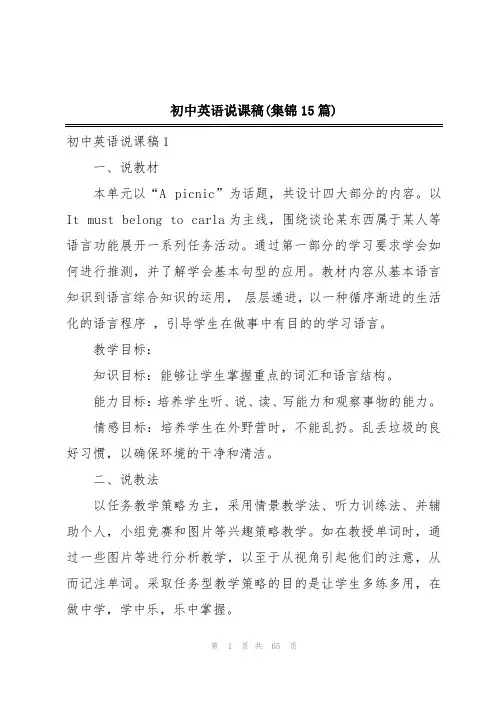
初中英语说课稿(集锦15篇)初中英语说课稿1一、说教材本单元以“A picnic”为话题,共设计四大部分的内容。
以It must belong to carla为主线,围绕谈论某东西属于某人等语言功能展开一系列任务活动。
通过第一部分的学习要求学会如何进行推测,并了解学会基本句型的应用。
教材内容从基本语言知识到语言综合知识的运用,层层递进,以一种循序渐进的生活化的语言程序,引导学生在做事中有目的的学习语言。
教学目标:知识目标:能够让学生掌握重点的词汇和语言结构。
能力目标:培养学生听、说、读、写能力和观察事物的能力。
情感目标:培养学生在外野营时,不能乱扔。
乱丢垃圾的良好习惯,以确保环境的干净和清洁。
二、说教法以任务教学策略为主,采用情景教学法、听力训练法、并辅助个人,小组竞赛和图片等兴趣策略教学。
如在教授单词时,通过一些图片等进行分析教学,以至于从视角引起他们的注意,从而记注单词。
采取任务型教学策略的目的是让学生多练多用,在做中学,学中乐,乐中掌握。
三、说学法采用合作式学习方式,有目的的让学生预习,在完成任务的活动中主动的学习语言。
养成继续学习英语、学好英语的良好习惯。
并让学生学会如何推测,以至于在做推测性的阅读题时有很好的方法。
强调学生不仅在课上积极发言、多练,并鼓励他们课后成立英语学习兴趣小组、英语角等,积极参加训练。
四、说教学过程1、课前任务设置。
在每一节课,我让学生提前预习,课前三分钟,我让学生学唱“Are you sleeping ”的歌曲。
目的是激发他们的学习热情。
另一方面,铃声响的时候,首先检查学生对第四单元的识记情况。
然后让学生看屏幕,用“Who is he ?” 句子问,用“It can?t、may 、must be ”等回答,之后通过“Look and learn”推出新单词“belong、belong to” 和教授的单元。
在此期间,让学生感知的重点句型结构。
把单词的教学融入句型,培养学生情景中理解单词的能力。
初二英语说课稿范文5篇
初二英语说课稿范文5篇一、说教材动词是句子的脊梁,动作发生的时间不同,它们在英语中的表现形式也不同,使英语句子变得生动而富有生命力,这就是动词时态。
学生只有通过掌握正确的时态才能把单词、短语连成一体,形成活生生的句子,从而组成有生命力的篇章。
因此动词时态在英语语法中具有不可动摇、不可替代的位置,是英语语法中的基础。
在初中阶段主要有八种基本时态,它们是一般现在时、一般过去时、一般将来时、现在进行时、现在完成时、过去进行时、过去完成时和过去将来时。
在七年级时已经学习了一般现在时,一般过去时和现在进行时。
八年级本学期学习十个单元的学习有五个单元涉及时态问题,时态问题贯穿整个英语学习,既是重点又是难点,所以非常有必要对时态问题进行总结归纳。
A:知识目标1)掌握动词的五种基本形式2)掌握五种基本时态的概念、结构及基本用法B:能力目标通过在练习中比较学习,学会如何分析句子的时态并能正确运用基本时态写出语法正确的句子和篇章。
C:情感目标在学习过程中培养学生克服困难的决心和勇气,培养互助互学的美德,增进同学间的友谊。
D.复习重点和难点五种基本时态的概念、结构及用法;教学难点为如何区别五种基本时态。
二、说学生由于各个时态都是在以前各个单元教学中分散学习的,那时很多同学还是学得不错。
但后来由于时态的不断增加和其他语法的不断出现,随着时间推移所产生的遗忘,使学生对各种时态产生了混淆,主要是时态名称和结构容易张冠李戴。
那麽怎样使学生对基本时态清清楚楚,通过复习对学生进行查漏补缺,巩固提高,让他们准确得掌握时态。
三、说教法要求学生在“用中学,学中用”,复习课的任务是梳理知识,查漏补缺,巩固提高。
所以在教学程序上充分利用准备好的复习资料,由浅入深,步步深入;在教学方式上以练为主线,让学生在练中分析,练中比较,练中探究,练中互助,练中提高;通过练习由混乱变清晰,由糊涂变明白,由理解到运用。
四、说学法学生是学习的主体,个体差异各不相同。
八年级英语说课稿7篇
八年级英语说课稿八年级英语说课稿7篇作为一位杰出的老师,时常需要编写说课稿,说课稿有助于提高教师的语言表达能力。
快来参考说课稿是怎么写的吧!以下是小编为大家整理的八年级英语说课稿,欢迎阅读,希望大家能够喜欢。
八年级英语说课稿1一、教材分析Would you mind keeping your voice down? 是(中国)课程教材研究所、英语课程教材研究中心与(美国)汤姆森学习出版集团合编的九年级义务教育课程标准实验教科书英语新目标Go for it ! Students,Book 八年级下册Unit7的一篇阅读课文。
是对整个单元的升华。
在前几节课中学生学习了用Would you mind??有礼貌地对别人发出请求.。
本节课通过文章进一步加深对有礼貌请求的句式的理解和在生活中的具体运用。
同时通过对中西方礼节的对比和描述,使同学们认识到礼节在日常生活中的重要性。
千万不要忘记“有礼貌地发出请求”。
进一步提高学生听、说、读、写的综合素质能力。
本节课主要是通过“以学生为中心,教师为辅导”的教学原则(Learner -centered , teacher –assisted ),通过任务型教学( task-based learning )创造性地使用英语。
在“学中用,用中学”,从而培养学生的文明礼仪,以礼待人的优良品质。
通过对本节课的学习后,学生会自然而然地感到英语学习并非是空中楼阁,而是实实在在可以用他来提高我们的自身素质,增强我们交际能力的科目。
二、教学对象分析初中二年级学生有了一定的英语知识,求知欲也很强。
所以本节课采用“把课堂还给学生”,“学生自学为主,教师为辅”的教学指导思想,并通过网络搜集到一些学生感兴趣的图画及动画材料。
这样学生的学习兴趣会大大提高。
三、教学目标分析(一)语言技能目标1、能连贯流畅地朗读课文。
2、能从文章中找出有关信息,理解大意。
(二)语言知识目标1、词汇(听、说、读、写)voice ,term ,Asian, Europe, ,impolite, allow, public ,cough, smoke ,drop ,litter, pick?up, behave2.语法理解“Would you mind doing?”的基本形式和表意功能。
初中英文说课稿
初中英⽂说课稿初中英⽂说课稿范⽂(精选5篇) 作为⼀名教职⼯,有必要进⾏细致的说课稿准备⼯作,写说课稿能有效帮助我们总结和提升讲课技巧。
写说课稿需要注意哪些格式呢?以下是⼩编整理的初中英⽂说课稿范⽂模板(精选5篇),欢迎阅读,希望⼤家能够喜欢。
初中英⽂说课稿1 ⼀、说教材(教材分析) Analyzing teaching material 1. 说课型 lesson type (Dialogue/ reading/ listening/ revision) 2. 本课在教材中的地位 status and function Lesson 33 Saving the Earth is a dialogue. The lesson is focused on the topic of the problems of the earth and the functional items of Supposition/ Intentions/ conjecture/ Prohibition. Since it is a dialogue / reading. It’s helpful to improve the Ss communicative/ reading ability. 3. 说教学指导思想 teaching guideline (Teaching syllabus: Language is for communication, develop their four skills, lay special emphasis on reading; Grellet put it well in his book developing reading skills: develop reading skill/ discourse analysis; get them to understand the western culture better; improve the ability to discover, analyze & solve the problems; Reading is for information, for fun; Use Top- down model or Bottom- up model to activate Ss schemata; Interactive model) 4. 说教学⽬标和要求 Teaching aims and demands (…be intended for Ss in key schools) 1)认知⽬标 knowledge objects a. Enable the Ss to remember the following new words & phrases: Damage, lecture, pollute, pollution, room, standing room, be fit for, hear about, turn into b. Get the Ss to be familiar with this sentence pattern: If the population keeps growing so quickly, there will only be standing room left… Give the Ss a reinforced practice on the functional item Supposition. c. Activate Ss schemata regarding the topic of pollution and help Ss to know more about the problem of pollution. 2)智能⽬标 ability objects a. Ask the Ss to make up a similar dialogue. b. Help them to understand the dialogue better and improve the four skills. c. Develop their ability of thinking independently. d. Cultivate their ability to discover, analyze and solve problems. e. Train them to collect information from the Internet. f. Train them with some effective learning methods to optimize Ss’ learning results. 3)德育⽬标 moral objects a. Arouse their interest in learning English; b. Help them to understand the background of pollution. c. Enable the students to love our earth and the nature. d. Be aware of the importance of stopping pollution & protecting our environment. e. Encourage the Ss to do something to save the earth. 5. 说教学重点 teaching important points (⽣词、句型;培养阅读技能) a. New words and phrases b. Sentence pattern: If- clause c. improve their reading skills. d. Talking about problems of the Earth. 6. 说教学难点 teaching difficult points (语法;发展交际能⼒) a. functional item: Supposition. b. Develop their communicative ability. Act out their own dialogue. 7. 说教具 teaching aids (multi-media computer, software, OHP) The teaching syllabus says that it’s necessary for teachers to use modern teaching facilities. It’s of great help to increase the class density and improve our teaching result. It can also make the Ss reach a better understanding of the text by making the classes lively and interesting. At the same time, it arouses the Ss’ interest in learning English. ⼆、说教法 Teaching methods Five step method; audio-video; communicative approach; Task-based learning: New Syllabus Design encourages teachers to use this teaching method. TBLT can stimulate Ss’ initiative in learning and develop their ability in language application. Make the Ss the real masters in class while the teacher himself acts as the director and bring their ability into full play. 三、说学法 Study methods 1. Teach Ss how to be successful language learners. 2. Teach Ss how to develop the reading skill — skim & scan; how to communicate with others; how to learn new words; how to learn independently; 3. Get the Ss to form good learning habits. 四、说教学过程Teaching procedures I. 复习(Revision) 5min (Daily report; 词汇diagram; brainstorming; activate schemata) Activity 1: Imagination 1) Suppose a bottle of ink is turned over and dirties your white shirt, what is to be done? (Wash it? Or throw it away?) 2) Suppose you catch a bad cold, what’s to be done? 3) Suppose your bike is broken, what’s to be done? 4) And suppose the earth, on which we all live, is damaged, what’s to be done? * What can you think of when you see "pollution" this word?(waste, environment, air, water, factory, desert, climate…Try to activate the Ss schemata regarding the topic of pollution.) II. 呈现(Presentation) 5min Activity 2: Presentation Play the song "Earth Song" sung by Michael Jackson. (Create an atmosphere) A lot of pictures and video clips about the causes and results of the three problems mentioned in this lesson will be shown on the screen with the help of the computer. Ss’ presentation on pollution. Attract their attention, arouse their interest, and create a good atmosphere for communication. * Activate their schemata and cultivate their ability in collecting information from the Internet and develop their ability in thinking independently. III. 对话 / 阅读(Dialogue)18m 1. Pre- reading Activity 3: Prediction 1st listening/ fast reading, one guided Q to help Ss to get the main idea: What do you think is discussed at the conference? 2. While- reading Activity 4: Read and answer 2nd listening/ careful reading, more Qs to get the detailed information. Develop their reading skills: skim & scan. Pay attention to the pronunciation, stress & intonation. * 阅读: Pre-reading; while-reading; post-reading (fast reading/ careful reading; skim/ scan; 识别关键词key words;确定主题句;创设信息差information gap;T or F; 填表格chart/diagram; Predicting; Make a timeline; Make a story map.达到对课⽂的`整体理解和掌握。
初二英语说课稿(精选5篇)
初二英语说课稿(精选5篇)初二英语说课稿(精选5篇)所谓说课,就是教师备课之后讲课之前(或者在讲课之后)把教材、教法、学法、授课程序等方面的思路、教学设计、下面是我给大家整理的初二英语说课稿,希望能给大家带来帮助。
初二英语说课稿(精选篇1)一、说教材1、教材的地位和作用在单元第10课是一篇题为“MAKF OUR WORLD MORE BEAUTIFUL 的阅读教材,通过对环境保护这一话题的叙述增强学生环境保护的意识,懂得如何在日常生活中保护环境,文中主要运用现在完成时态的句子,其中也穿插了一般现在时和过去时,学生在特定的语境中感觉和发现英语时态的变化,从而达到正确运用英语的时态能力。
2、教学目的教学大纲指出要从英语的学科的特点出发,激发培养学生的兴趣,帮助学生树立学习英语的信心,克服学习中产生的畏惧心理和困难,建立语感,掌握语言基本知识和技能。
(1)知识目标这一课的知识目标很明确,就是围绕“环境保护”这一话题,继续学习和巩固现在完成时态的用法,利用本课所学习的话题,把功能与语法教学紧密结合一起。
(2)能力目标本课首先利用课前问题(pre-reading questions ),启发学生利用已有的知识经验,对课文内容进行预测,就有关话题开展讨论,通过阅读验证自己的推测,吸取信息,掌握新的知识,丰富经验,从而达到独立阅读的能力。
3、教材的重点、难点、关键(1)重点:本课重点在其运用完成时态的句子谈论环保这一话题。
(2)难点:对课文内容及时态含义的理解。
(3)关键:在于是否能突破难关,达到正确运用完成时态表达句意、理解全文的目标。
初二英语说课稿(精选篇2)一、说教材(一)、教材的地位和作用本单元以How do you get to school?为中心话题,围绕交通方式而展开,主要运用How long/How far 询问“去某地的交通方式、时间、距离。
”简单描述路线。
这一话题贴近学生们的日常生活,它继第三单元谈论“假日计划”后安排这样一个话题,符合学生的认知结构和年龄特征,它将为后几个单元的学习打下坚定的语言基础。
